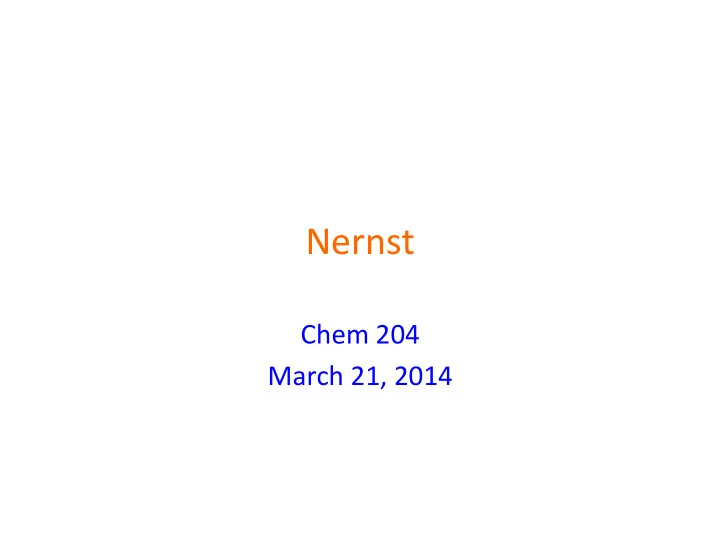

Nernst ¡ Chem ¡204 ¡ March ¡21, ¡2014 ¡
1864 ¡– ¡1941; ¡Nobel ¡Prize ¡1920 ¡for ¡third ¡law ¡of ¡thermodynamics ¡
The ¡Nernst ¡EquaFon ¡ From ¡the ¡relaFonship ¡between ¡free ¡energy ¡under ¡ standard ¡condiFons ¡and ¡free ¡energy ¡under ¡nonstandard ¡condiFons ¡ ¡ ¡ ¡
ConcentraFon ¡Cells ¡ • Consider ¡the ¡cell ¡ presented ¡on ¡the ¡leJ. ¡ ¡ • The ¡1/2 ¡cell ¡reacFons ¡ are ¡the ¡same, ¡it ¡is ¡just ¡ the ¡concentraFons ¡ that ¡differ. ¡ ¡ • Will ¡there ¡be ¡electron ¡ flow? ¡
ConcentraFon ¡Cells ¡(cont.) ¡ Ag + ¡+ ¡e -‑ ¡ ¡ ¡ ¡ ¡ ¡ ¡ ¡ ¡ ¡ ¡ ¡ ¡ ¡ ¡ ¡Ag ¡ ¡ ¡ ¡ ¡ ¡ ¡ ¡E° 1/2 ¡= ¡0.80 ¡V ¡ • ¡What ¡if ¡both ¡sides ¡had ¡1 ¡M ¡ ¡ ¡ ¡concentraFons ¡of ¡Ag + ? ¡ • ¡E° 1/2 ¡would ¡be ¡the ¡same; ¡ ¡ ¡ ¡therefore, ¡E° cell ¡= ¡0. ¡
ConcentraFon ¡Cells ¡(cont.) ¡ Ag ¡ ¡ ¡ ¡ ¡ ¡ ¡ ¡ ¡ ¡ ¡ ¡Ag + ¡+ ¡e -‑ ¡ ¡ ¡ ¡ ¡ ¡ ¡E 1/2 ¡= ¡? ¡V ¡ Anode: ¡ Cathode: ¡ Ag + ¡+ ¡e -‑ ¡ ¡ ¡ ¡ ¡ ¡ ¡ ¡ ¡Ag ¡ ¡ ¡ ¡ ¡ ¡ ¡ ¡ ¡ ¡E 1/2 ¡= ¡0.80 ¡V ¡ Overall: ¡ ¡Ag(anode) ¡+ ¡Ag + (cathode) ¡ à ¡Ag + (anode) ¡ ¡+ ¡Ag(cathode) ¡ [ ] anode Ag + = 0.1 Q = 1 = 0.1 [ ] cathode Ag + E cell ¡= ¡E° cell ¡-‑ ¡(0.0591/n)log(Q) ¡ 0 ¡V ¡ 1 ¡ E cell ¡= ¡-‑ ¡(0.0591)log(0.1) ¡= ¡0.0591 ¡V ¡
ConcentraFon ¡Cells ¡(cont.) ¡ Another ¡Example: ¡ What ¡is ¡E cell ? ¡
ConcentraFon ¡Cells ¡(cont.) ¡ E cell ¡= ¡E° cell ¡-‑ ¡(0.0591/n)log(Q) ¡ e -‑ ¡ 2 ¡ 0 ¡ Fe 2+ ¡+ ¡2e -‑ ¡ ¡ ¡ ¡ ¡ ¡Fe ¡ 2 ¡e -‑ ¡transferred…n ¡= ¡2 ¡ [ ] anode Fe 2 + = 0.01 Q = .1 = 0.1 [ ] cathode Fe 2 + anode ¡ cathode ¡ E cell ¡= ¡-‑(0.0296)log(.1) ¡= ¡0.0296 ¡V ¡
Measurement ¡of ¡pH ¡ • pH ¡meters ¡use ¡electrochemical ¡reacFons. ¡ • Ion ¡selecFve ¡probes: ¡ ¡respond ¡to ¡the ¡presence ¡of ¡ a ¡specific ¡ion. ¡ ¡pH ¡probes ¡are ¡sensiFve ¡to ¡H + . ¡ • Specific ¡reacFons: ¡ Hg 2 Cl 2 (s) ¡+ ¡2e -‑ ¡ ¡ ¡ ¡ ¡ ¡ ¡ ¡ ¡ ¡ ¡ ¡ ¡ ¡ ¡ ¡ ¡ ¡ ¡ ¡ ¡2Hg(l) ¡+ ¡2Cl -‑ (aq) ¡ ¡ ¡ ¡ ¡ ¡ ¡ ¡ ¡ ¡ ¡ ¡ ¡ ¡ ¡ ¡ ¡ ¡ ¡ ¡ ¡ ¡ ¡ ¡ ¡ ¡ ¡E° 1/2 ¡= ¡0.27 ¡V ¡ ¡ ¡ ¡E° 1/2 ¡= ¡ ¡0.0 ¡V ¡ H 2 (g) ¡ ¡ ¡ ¡ ¡ ¡ ¡ ¡ ¡2H + (aq) ¡+ ¡2e -‑ ¡ Hg 2 Cl 2 (s) ¡+ ¡H 2 (g) ¡ ¡ ¡ ¡ ¡ ¡ ¡ ¡ ¡ ¡ ¡2Hg(l) ¡+ ¡2H + (aq) ¡+ ¡2Cl -‑ (aq) ¡ E° cell ¡= ¡ ¡0.27 ¡V ¡
Measurement ¡of ¡pH ¡(cont.) ¡ Hg 2 Cl 2 (s) ¡+ ¡H 2 (g) ¡ ¡ ¡ ¡ ¡ ¡ ¡ ¡ ¡ ¡2Hg(l) ¡+ ¡2H + (aq) ¡+ ¡2Cl -‑ (aq) ¡ • ¡ ¡What ¡if ¡we ¡let ¡[H + ] ¡vary? ¡ 2 Cl ! [ ] [ ] 2 H + 2 Cl ! [ ] [ ] 2 = H + Q = P H 2 E cell ¡= ¡E° cell ¡-‑ ¡(0.0591/2)log(Q) ¡ E cell ¡= ¡E° cell ¡-‑ ¡(0.0591/2)(2log[H + ] ¡+ ¡2log[Cl -‑ ]) ¡ constant ¡ E cell ¡= ¡E° cell ¡-‑ ¡(0.0591)(log[H + ] ¡+ ¡log[Cl -‑ ]) ¡ saturate ¡
Measurement ¡of ¡pH ¡(cont.) ¡ E cell ¡= ¡E° cell ¡-‑ ¡(0.0591)log[H + ] ¡+ ¡constant ¡ • ¡ ¡E cell ¡is ¡directly ¡proporFonal ¡to ¡log ¡[H + ] ¡ electrode ¡
Nernst ¡and ¡neurobiology ¡
General ¡thoughts ¡on ¡solving ¡problems ¡ • Nernst ¡only ¡helps ¡you ¡with ¡the ¡redox ¡reacFon ¡ • If ¡a ¡species ¡in ¡the ¡redox ¡reacFon ¡also ¡shows ¡ up ¡in ¡another ¡equilibrium ¡(Ka, ¡Ksp), ¡you ¡can ¡ usually ¡use ¡the ¡measured ¡potenFal ¡to ¡figure ¡ out ¡the ¡amount ¡of ¡that ¡species ¡and ¡therefore ¡ calculate ¡Ksp ¡or ¡Ka; ¡this ¡is ¡how ¡we ¡can ¡ measure ¡super-‑Fny ¡or ¡super-‑giant ¡K’s ¡
Recommend
More recommend